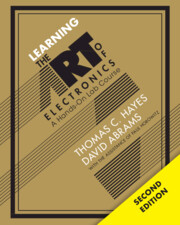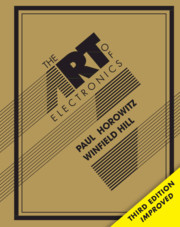Learning the Art of Electronics
The much-anticipated new edition of 'Learning the Art of Electronics' is here! It defines a hands-on course, inviting the reader to try out the many circuits that it describes. Several new labs (on amplifiers and automatic gain control) have been added to the analog part of the book, which also sees an expanded treatment of meters. Many labs now have online supplements. The digital sections have been rebuilt. An FPGA replaces the less-capable programmable logic devices, and a powerful ARM microcontroller replaces the 8051 previously used. The new microcontroller allows for more complex programming (in C) and more sophisticated applications, including a lunar lander, a voice recorder, and a lullaby jukebox. A new section explores using an Integrated Development Environment to compile, download, and debug programs. Substantial new lab exercises, and their associated teaching material, have been added, including a project reflecting this edition's greater emphasis on programmable logic.
- Teaches electronics in day-at-a-time practical doses so that students can learn in a hands-on way
- The integration of discussion of design with a chance to try the circuits means students learn quickly
- Accompanied by a companion web site LAoE.link that redirects the printed links in the book to the actual Internet reference
- Additional online chapters cover breadboarding hints & tips, alternatives to the microcontroller and FPGA, creating Verilog test benches, and up-to-date lists of equipment and sources for parts
- Provides a complete introduction to embedded programming, beginning with blinking an LED and ending with a complex application using a Real Time Operating System (RTOS)
- Offers a simple, device-agnostic introduction to programmable devices using an online development system that runs in a browser
Product details
No date availablePaperback
9781009535182
1180 pages
253 × 203 mm
Table of Contents
- Preface to the second edition
- Preface to the first edition
- Overview, as the course begins
- Part I. Analog: Passive Devices:
- 1. DC circuits
- 2. RC circuits
- 3. Diode circuits
- Part II. Analog: Discrete Transistors:
- 4. Transistors I
- 5. Transistors II
- Part III. Analog: Operational Amplifiers and their Applications:
- 6. Op-Amps I
- 7. Op-Amps II: Departures from ideal
- 8. Op-Amps III: Nice positive feedback
- 9. Op-Amps IV: Parasitic oscillations
- active filter
- 10, Op-Amps V: PID motor control loop and lock-in amplifier
- 11. Voltage regulators
- 12. MOSFET switches and an introduction to JFETs
- 13. Group audio project
- Part IV. Digital: Gates, Flip-Flops, Counters, PLD, Memory:
- 14. Logic gates
- 15. Introduction to programmable logic
- 16. Flip-Flops
- 17. Counters
- 18. Memory
- 19. Finite state machines
- Part V. Digital: Analog–digital, PLL, Digital project lab:
- 20. Analog ↔ digital
- PLL
- 21. Digital project lab
- Part VI. Microcontrollers:
- 22. Microcontrollers I: Introduction
- 23. Microcontrollers II: Stacks, timers and input
- 24. Microcontrollers III: Using internal peripherals
- 25. Microcontrollers IV: Timers & interrupts
- 26. Microcontrollers V: Serial communication
- 27. Microcontrollers VI: Using an RTOS
- 28. Project possibilities: toys in the attic
- A. Debugging circuits
- B. Pinouts
- C. Transmission lines
- D. Scope advice
- O. Online appendices
- Index.




